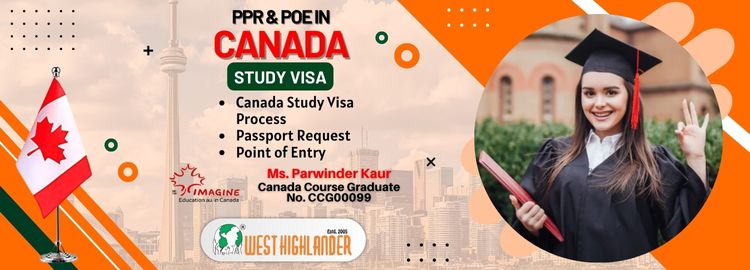Indian students who want to study in Canada are in a great dilemma about the Canada Study Visa process, and they have no idea about PPR and POE in Canada Study Visa Application. Most Indian students want to study in Canada but have no idea about the Canada study visa process or what documents are needed to submit an application for a Canada study visa.
West Highlander is the best immigration consultant in Chandigarh and has been helping Indian students for the past 17 years in order to get their Canada study visa. This article contains step-by-step information from the beginning of the application to the approval of the application and the steps that are needed to be taken after your visa approval. The article will also tell about PPR in Canada Study Visa Application and POE in Canada Study Visa.
In this article
- Canada Study Visa Process
- PPR in Canada or Passport Request in Canada
- POE/ Introductory Letter/ Correspondence letter/ Letter of Introduction
Canada Study Visa Process
The first step is to decide which program you wish to enroll in Canada. The first the most crucial step in obtaining a study visa for Canada is this one. You must chose a program that is appropriate for your prior academic experience. If you select a course of study that is wholly unrelated to your prior coursework, the case officer might reject your application, and you will not be granted a study visa for Canada. To obtain a Canada Study Visa, Indian students must be eligible and meet the English language standards.
Obtaining an offer letter to study in Canada is the second step in the application procedure for a study visa for Canada. You can apply for an offer letter once you have decided on the program you want to enroll in in Canada. Along with your request for an offer letter, you must submit the following paperwork:
- Previous academic qualification certificates
- IELTS or PTE score evidence
- Your identity proof (passport copy)
- Statement of purpose (SOP)
- Previous work experience documents
- Appointment and experience letter
India students may have to pay the fees at this stage if required by the institution.
Paying the tuition for your chosen program is the third step in the procedure. This will guarantee the Indian students a spot in the program of their choice.
Opening a GIC account is the fourth stage in the application procedure for a study visa in Canada. To demonstrate to Canadian institutions that you have enough money in your account to meet your living expenses, this is done.
You must complete your medical exam before submitting your application. You must schedule a consultation with the doctor on the list of panel physicians. There is a list of documents that are required to get a Canada study visa-
- Complete application form
- Passport copy
- LOA- Letter of Acceptance
- Proof of payment of tuition fees
- IELTS/PTE proof
- GIC certificate
- Statement of purpose (SOP)
- Additional Funds (for Non SDS category)
Submitting the Canada student visa application is the final step in the 2023 process. Prior to submitting the file online, the applicants must pay the visa fee.
PPR in Canada or Passport Request in Canada
Once your file has been lodged, you will get a PPR, or Passport Request, from the processing office if your visa has been approved. Applicants need to submit their electronic photos as part of the application. PPR in Canada Study Visa also includes a request for hard copies of photos. You need to send a valid passport to the processing office.
After you get your PPR, your passport will need stamping at VFS daily, which is a 2-week process. Within 2 days after your passport gets stamped, you will get your POE.
POE/ Introductory Letter/ Correspondence letter/ Letter of Introduction
POE, Port of Entry is only received by those students who get their study permit visa, work permit visa or visitor visa. POE is also known as letter of introduction, introductory letter and correspondence letter. Point of Entry in Canada is only received to those students who have get their letter approved if you have applied online or put their email-address. When you arrive in Canada, you need to tell the officer at the port of entry about your application approval show your letter of introduction. If you don’t have a printed copy of your letter of introduction, you can show your correspondence letter online.

